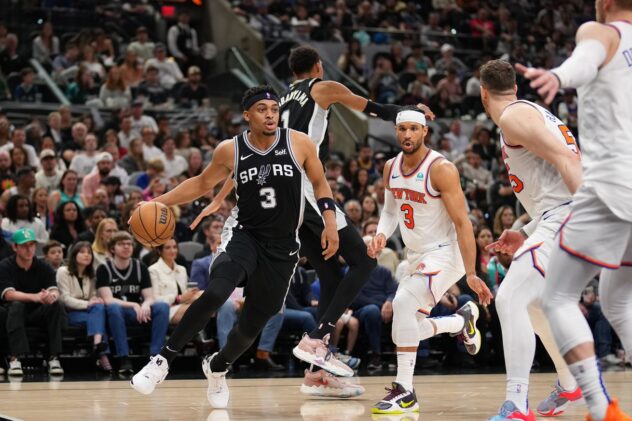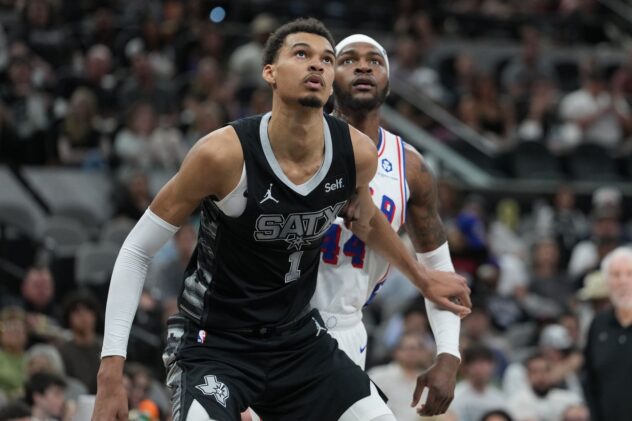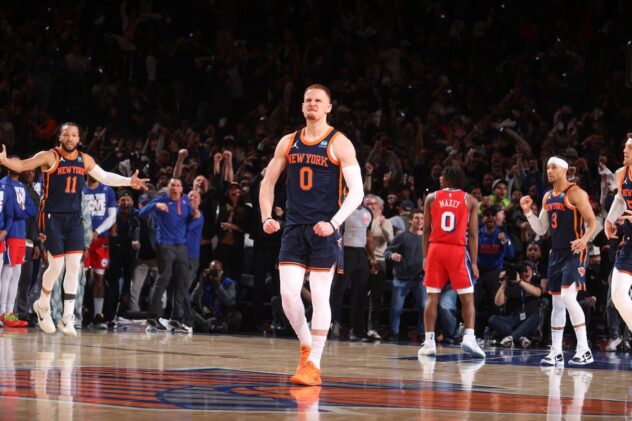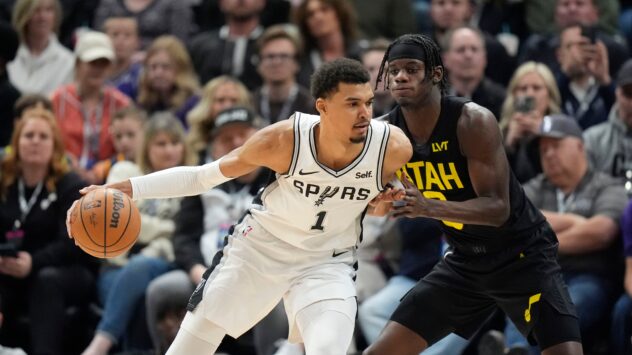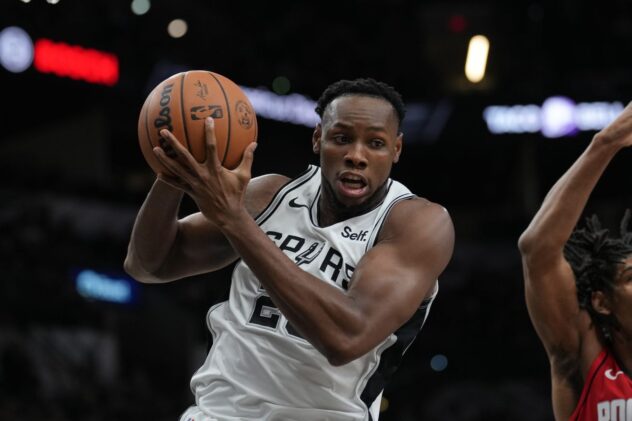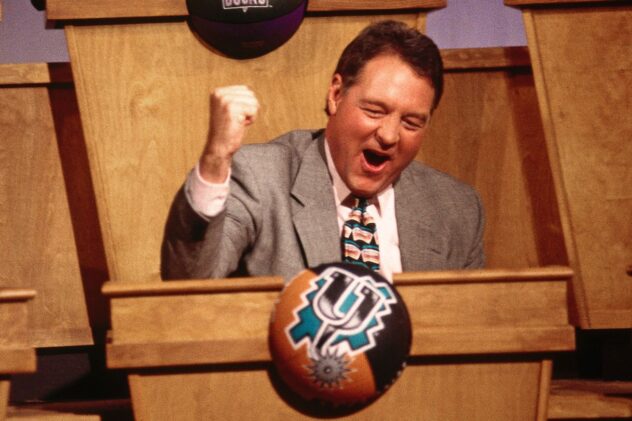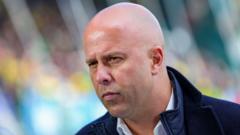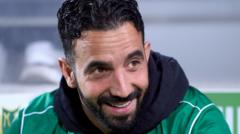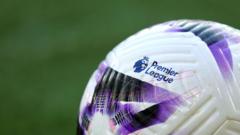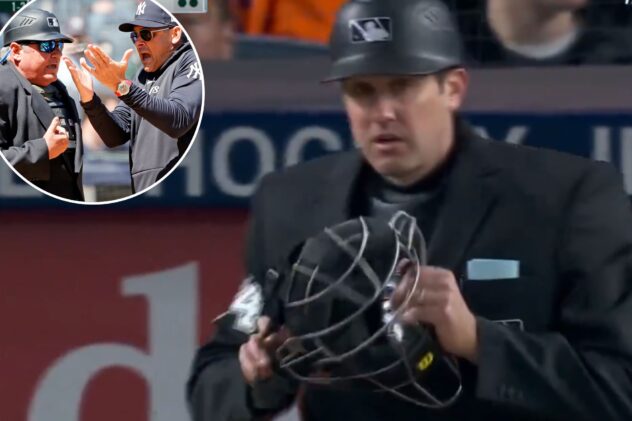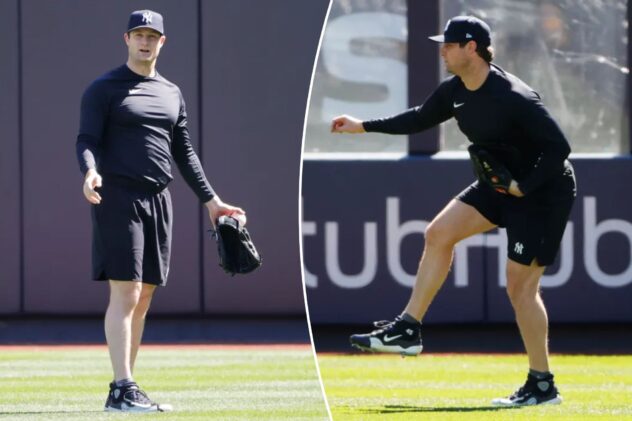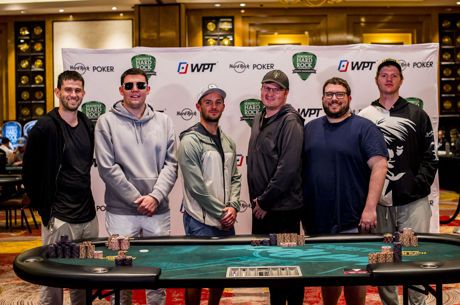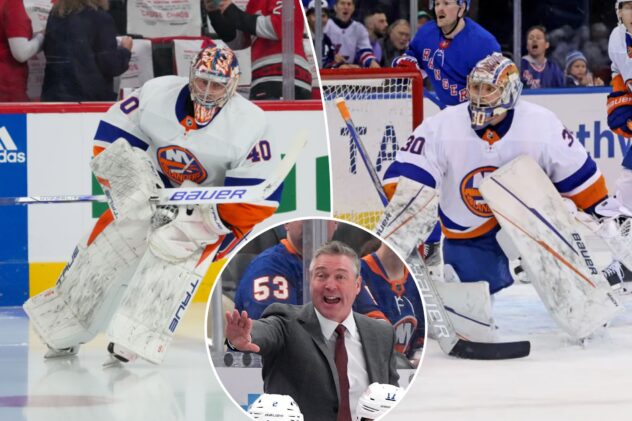We might have been wrong about why the Spurs’ defense is struggling
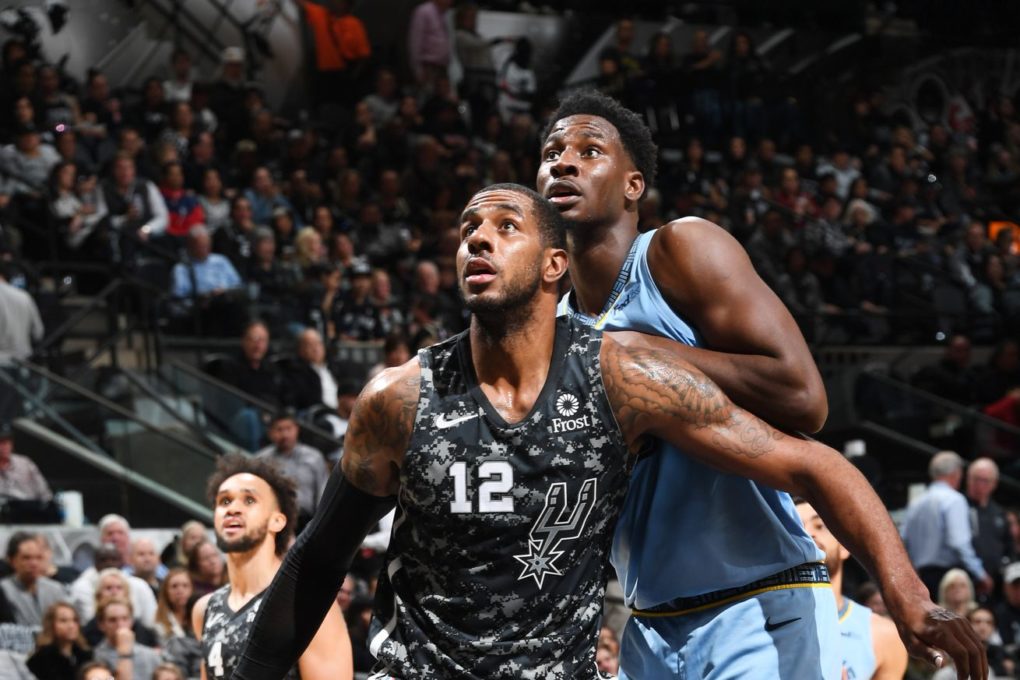
Photos by Andrew D. Bernstein/NBAE via Getty Images
And there’s no immediate reason to hope for improvement.
Much of the focus on the Spurs’ defensive struggles has centered on their inability to guard the perimeter. With Dejounte Murray and Derrick White both out to begin the 2018-19 season, missed switches, blow-bys, and uncontested shots became a new norm. But the return of Derrick White didn’t exactly end all that. Though the defense was better with him in the lineup, it never came close to reaching its 2017-18 form.
Of course, that team also had Kyle Anderson and Danny Green eating up huge chunks of minutes, and last year’s squad replaced them with DeMar DeRozan and Marco Belinelli. The offense got better and the defense got worse, just as expected. But heading into this season, it seemed like the defense would take another step back towards respectability with a healthy Dejounte Murray joining Derrick in the backcourt.
Though the two have only shared the floor for 6 possessions thus far, the Spurs have had both available for all but one game and have played just 53 of their 480 total minutes with neither on the court. Put another way, one or both of Derrick and Dejounte have been on the court for 437 of those 480 minutes. Compared to the first 10 games of last year, that’s an increase of – *checks notes – 421 minutes. It seems reasonable to expect the defense would be better so far this year.
Unfortunately, that’s not the case. Through the first 10 games of last season, the squad allowed 111.0 points per 100 possessions, which was 1.4 points above league average to that point. This year’s team is allowing 110.5 points per 100 possessions, while league average scoring has actually decreased to just above 108 points per 100, leaving the Spurs 2.4 points per 100 possessions above league average. They are giving up almost as many points as a year ago and more points relative to how the rest of the league is performing, a disappointing development that does not bode well for the rest of the season.
Little has changed with respect to opponent performance in the four factors.
/cdn.vox-cdn.com/uploads/chorus_asset/file/19373375/2018_20_Spurs_OppFourFactors4.png)
Stats from CleaningTheGlass.com as of 12 Nov 2019
Their opponents continue to knock down shots at an considerable clip, with a 53.4 eFG%, 10th worst in the league per Cleaning the Glass (CTG). Meanwhile, the Spurs are sporting the 2nd lowest opponent turnover rate in the league and, perhaps more importantly, the 2nd lowest opponent live ball turnover rate.
The team’s low steal rate is surprising, especially with Dejounte back in the fold. That’s certainly an area that could improve once his minutes restriction is lifted and one which could have a dramatic impact on the team’s performance. An extra run-out or two every game would go a long way towards covering up the team’s warts on both ends of the floor. But last year’s team didn’t generate many turnovers, either.
They’re actually better on the defensive glass this season, holding their opponents to an offensive rebound rate of just 21.1%, good for third in the league, and continue to do an excellent job of defending without fouling. Their opponent free throw rate, 17.9%, is 5th in the league and right in line with last year’s numbers.
The team’s defensive shot profile has improved from last season as well.
/cdn.vox-cdn.com/uploads/chorus_asset/file/19373377/2018_20_Spurs_OppShotProfile3.png)
Stats from CleaningTheGlass.com as of 12 Nov 2019
They’re giving up fewer shots at the rim, forcing more midrangers, and allowing fewer threes, both from the corner and above the break. If their opponents were shooting even close to the same percentages as last season, that would result in a dramatic defensive improvement. Unfortunately, that hasn’t been the case.
/cdn.vox-cdn.com/uploads/chorus_asset/file/19373381/2018_20_Spurs_OppShotAccuracy.png)
Stats from CleaningTheGlass.com as of 12 Nov 2019
The Spurs’ opponents have shot worse from most of the floor, with only a small improvement in above the break three point shooting, and a gigantic jump in accuracy at the rim, where they are converting nearly 70% of their attempts.
That puts the Spurs last in the league in opponent accuracy at the rim, which is newfound territory for the team. Last year’s squad finished 18th, which was the first time, essentially ever, that the Spurs have finished outside the top 10, and only the 2nd time they finished outside the top 6 since 2002-03 (the earliest season in CTG’s database).
The root cause of the problem, sadly, is easy to discern. Opponents are shooting 74.7% at the rim when LaMarcus Aldridge plays the 5, but only 62.4% when Jakob Poeltl takes his place. The Spurs give up fewer shots at the rim with LaMarcus on the court, but it’s not nearly enough to make up for the disparity in opponent accuracy.
Looking at individual shots defended within 6 feet of the basket, the difference is stark. After holding opponents to 52.5% shooting on those attempts last season, opponents are making 57.8% when LaMarcus is the closest defender this season. Jakob, on the other hand, is allowing opponents to make just 49.1% of those attempts when he’s the closest defender.
And the gap between the two may be even wider than that. Despite the fact that opponents have been unreasonably accurate on above the break threes with Jakob on the floor, hitting almost 43% of their 75 attempts, he has the 3rd best individual defensive rating on the team at 104.8. Every player who has spent more than 100 possessions on the floor with both LaMarcus and Jakob has a better defensive rating in their pairing with the Austrian big man.
5 Spurs have played more than 100 possessions with both LaMarcus Aldridge and Jakob Poeltl. All 5 have a better defensive rating in their time w/ JP. pic.twitter.com/MO4rdj0dpH
— CharlieOCharles (@CharlieOCharles) November 13, 2019
The tape shows some reasons for concern, too. LaMarcus has begun using the Pau Gasol Memorial drop coverage on the pick and roll at times, meaning he barely leaves the paint, regardless of whether the ball handler or the screener are shooting threats.
Dejounte forced that turnover, but if Aldridge doesn’t deserve a defensive 3 seconds call there, no player ever does.
It’s Bryn Forbes’ responsibility to contest the passing lane back to Jonas Valanciunas rolling down the right side of the lane, but LaMarcus gets so deep so quickly, he’s out of the play before it even develops, giving so much room for Dillon Brooks to operate that a basket was all but assured.
The thing is, LaMarcus doesn’t start this deep or retreat so quickly on every play, so perhaps it’s by design in some instances, though there doesn’t appear to be an easily identifiable pattern that would explain why. The result isn’t so bad when Dejounte Murray or Derrick White are the trailing defender, as both typically maintain contact with the roll man or recover to the ball handler in time to contest the shot. But when pretty much anyone else on the team is involved in the pick and roll, this kind of drop gives up too many easy decisions. It’s too predictable and there’s too much space to work with.
At the same time, athletic wings, like Jayson Tatum and Jaylen Brown of the Celtics drive right at LaMarcus with impunity, confident they can find an open look at rim.
There are obviously other defensive issues that put LaMarcus in these positions, but his inability to affect shots like these is directly linked to how easily the Spurs’ opponents are scoring at the rim with him on the floor.
Teams have started attacking Aldridge’s tendencey to stay close to the paint, too. Here are the Grizzlies intentionally getting LaMarcus switched onto Jackson Jr. early in their Monday night victory to set up a pick and pop for an open corner 3.
At the same time he appears to be playing more conservatively in terms of where he is on the floor, LaMarcus’ foul and block rates have both increased. He’s averaging 3.5 personal fouls per 100 possessions, his highest since 2012-13, and 2.6 blocks per 100 possessions, his highest since his rookie year. The change in both indicates an increase in activity, which, along with the tape, makes it seem like teams are purposefully going after him.
Jakob, on the other hand, was the defensive key to the Spurs’ 4th quarter surge that nearly stole the game. When Jakob started giving a hard show on ball screens, it completely disrupted the Grizzlies’ offense.
And that’s with Marco Belinelli responsible for handling the roll man and “sprinting” back out to the shooter at the arc in a couple of cases. Imagine what it would’ve looked like with DeMarre Carroll or Lonnie Walker IV in that position instead.
Once LaMarcus replaced Jakob with 7:42 to go, the Spurs reverted to their typical conservative scheme. And for the most part, LaMarcus did exactly what was expected of him: keeping the play in front of him and maintaining the ability to contest the ball handler’s shot while staying close enough to the roller to recover and compete for the rebound.
It can be difficult to separate out what a player is and isn’t capable of from what they’re asked to do within a scheme. It’s possible that LaMarcus still has the foot speed and agility to be more aggressive than this. But judging by how early he starts his drops and how difficult it is for him to change directions once he’s moving backwards, it sure looks an awful lot like a player who’s struggling to adapt as his athleticism declines.
There could be other issues at play (including injuries), and it could also just be a handful of bad nights. But whatever the problem, if LaMarcus can’t be the centerpiece of a top 10 defense, the Spurs are in desperate trouble.
Rudy Gay has become an excellent help defender and Trey Lyles has been more than passable at the 4 as well. Dejounte and Derrick are both phenomenal on that end and the Spurs still have the easiest kind of defensive improvement just ahead once Dejounte’s minutes restriction is lifted. But, honestly, none of that matters if the big in the middle of the Spurs’ scheme can’t even protect the rim at a league-average level.
So much of what the Spurs do is built upon the idea that they will keep their opponents away from the basket and effectively contest their shots once they get there. For 19 years, with #21 patrolling the paint, that wasn’t a problem. For pretty much the entire time, it didn’t matter if the Spurs played 1 or 2 weak defenders, Tim Duncan would clean up whatever mess they made with timing, positioning and communication. Timmy’s on the sidelines now, though, and the team he’s helping coach is in serious need of that kind of presence.
To be fair, even in his prime, Timmy might have found it difficult to lead a high level defense with DeMar DeRozan and Marco Belinelli taking up most of the minutes on the wing. And playing Patty Mills and Bryn Forbes alongside those two isn’t going to help things. Could Timmy have done it? Yeah, probably — but it wouldn’t have been easy.
So asking 34 year old LaMarcus Aldridge to do it probably isn’t fair. And that leads to some pretty uncomfortable questions: Is there a point where LaMarcus’ defensive limitations outweigh his offensive utility? Is there a point where what Jakob provides on defense is more important to the team than his shortcomings on the other end?
There are other ways to approach the problem, like increasing the minutes of players who play better defense, like Carroll and Walker IV. They could also go back to the twin towers arrangement they used to close last season, though that would probably require inserting Derrick back into the starting lineup. The team definitely has options when it comes to improving the defense, though each likely comes with an associated cost on the other end.
All in all, might be a bit early to be asking those questions (and I’m thankful I’m not the one who will have to answer them). But, if the Spurs defense doesn’t get turned around, that moment might come a lot sooner than many expected just a few short weeks ago.
We might have been wrong about why the Spurs’ defense is struggling
We might have been wrong about why the Spurs’ defense is struggling

